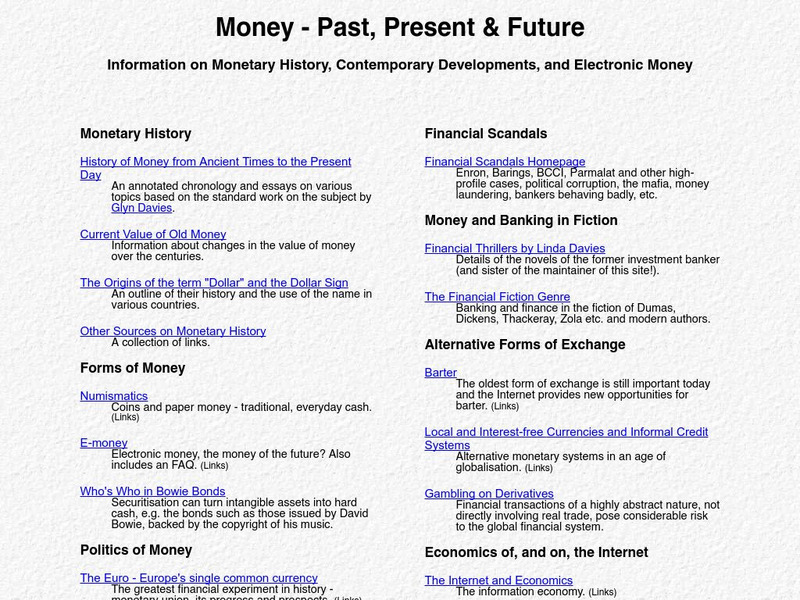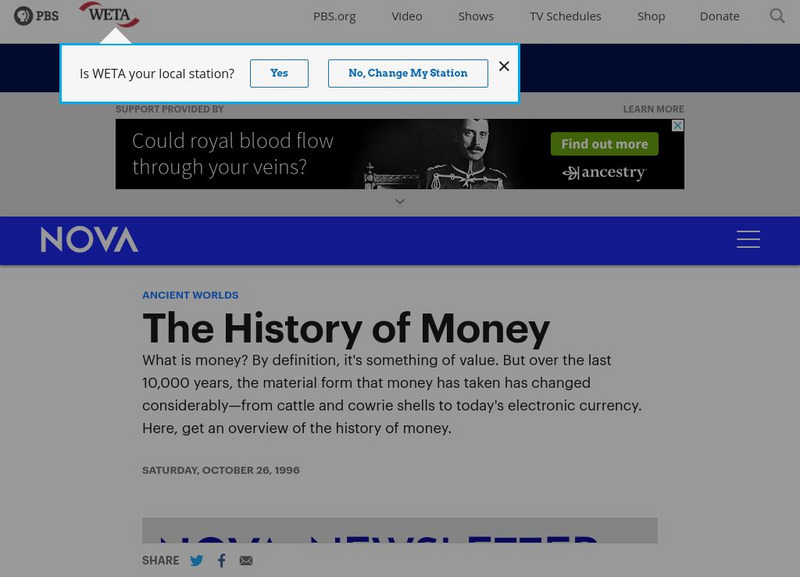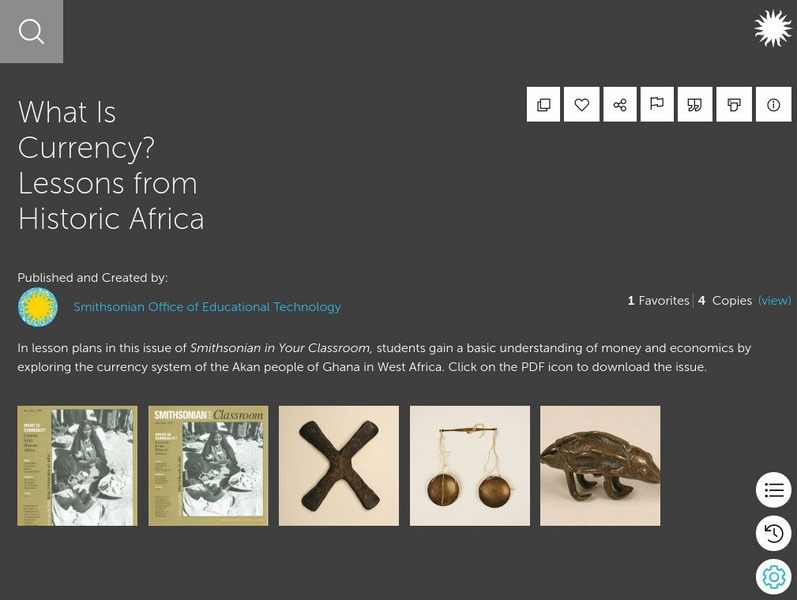Smithsonian Institution
National Museum of American History: Legendary Coins and Currency
Archived images of coins from a beautiful online exhibition on the history of money.
Edutopia
Edutopia: Goods and Services [Pdf]
A unit that teaches the difference between goods and services, the difference between producers and consumers, the difference between human, natural, and capital resources, and the difference between bartering/trading and buying/selling....
University of Nebraska Omaha
Ec Ed Web: Virtual Economics Web Companion
The Virtual Economics Web Companion for K-12 economics and social studies teachers was created by the National Council on Economic Education. A wide variety of educational materials and lesson plans can be accessed through this site....
Federal Reserve Bank
Federal Reserve Bank of Atlanta: Classroom Economist: What Is Money?
In this edition, the Classroom Economist offers a close look at money-its definition, the problem it solves, what fiat money accomplishes, and how the Yapese used giant wheels of stone for money.
Other
Federal Bank of Richmond: My Money
For elementary students, this booklet of activities teaches basic money skills and concepts. Includes lesson plans.
Federal Reserve Bank
Federal Reserve Bank of Philadelphia: What Is Money? [Pdf]
This lesson plan is designed to help children understand the problems which arise from the bartering system so they appreciate the role money has in society.
Social Studies Help Center
Social Studies Help Center: What Is Money?
Introduction explains what money is. This is followed by a brief history of commodity money and fiat money. Finally, this site explains the essential functions and characteristics of money.
Smithsonian Institution
Smithsonian Learning Lab: Revolutionary Money
A two-lesson plan unit using the Smithsonian collection of currency to teach students about the first American money. Other resources are given and all materials are downloadable.
TED Talks
Ted: Ted Ed: What Is a Gift Economy?
What if, this holiday season, instead of saying "thank you" to your aunt for her gift of a knitted sweater, the polite response expected from you was to show up at her house in a week with a better gift? Or to vote for her in the town...
Other
Roy Davies: Money
Explore the past, present, and future of money. Learn about exchange rates, money forms, banking, and more.
PBS
Nova Online: History of Money
A timeline of money from 9000 B.C. to the present day that explains the types of money being used at various times in history.
Council for Economic Education
Econ Ed Link: Lewis and Clark Barter With Native Americans
In this lesson you will define the term barter and give examples of bartering in several different areas. Find out how this system took shape and was useful to Lewis and Clark. This site is extremely informative and contains extension...
Council for Economic Education
Econ Ed Link: Pennies Make Cents
Students will review the history of trade before money and will investigate the history of money. Students will locate information about the first coin authorized by the United States and will learn about the penny.
Council for Economic Education
Econ Ed Link: Bill, Are You Bogus?
In a barter system, people have to trade goods and services for other goods and services. In an economy that produces millions of goods and services, barter is very difficult. Think of all the stuff (goods and services) you have.
Council for Economic Education
Econ Ed Link: Agent Pincher: P Is for Penny or Where Did Money Come From?
What if we woke up tomorrow and found that there were no more pennies? Or what if we found that money had disappeared altogether -- not only from our pockets but from banks, stores and all the other places where we would expect to find...
Council for Economic Education
Econ Ed Link: Lewis and Clark Barter With the Native Americans
Using the study of the Lewis and Clark expedition students will define the term barter and give examples of bartering.
Council for Economic Education
Econ Ed Link: No Funny Money, Honey I Want the Real Thing!
Do you know what funny money is? It's NOT the real thing! Find out how our government tries to make our money hard to copy in this lesson about real and fake money.
Council for Economic Education
Econ Ed Link: Trade to the Tailor: Student Version
Students can use this site online in conjuction with the teacher's lesson plan, "Trade to the Tailor."
Council for Economic Education
Econ Ed Link: I Have No Money, Would You Take Wampum?
Through the use of folk tales, history, and the students' own experiences, students will recognize the inter-relatedness of goods, services, money. They will locate information about barter as a means of trade, use folk tales as an...
Council for Economic Education
Econ Ed Link: Hawaiian Economics: Barter for Fish & Poi
In ancient Hawaii, chiefs managed the economy by creating a land division system, the Ahupua'a, which divided the islands into pie slice shapes. Each Ahupua'a covered the three main regions of the islands: the mountains, the valleys, and...
Council for Economic Education
Econ Ed Link: Hawaiian Economics: Barter for Fish & Poi
Use this lesson to learn more about the Hawaiian economics system. Learn how they developed and used this specialized type of money system. "In this lesson, you will learn how specialization and division of labor increased productivity...
Council for Economic Education
Econ Ed Link: Why Do We Need Money? Think About Ebay!
The students investigate money--its purpose and functions. They complete an exercise, using the online auction site eBay, to learn why money is critical to an economy.
Federal Reserve Bank
Federal Reserve Bank of Philadelphia: Why Money? [Pdf]
Young scholars learn about barter, and the benefits of using money, as they participate in this trading simulation.
Smithsonian Institution
Smithsonian Learning Lab: What Is Currency? Lessons From Historic Africa
From the Smithsonian, this site offers lessons and resources on currency, its use (in the form of gold dust, salt, or metal objects) as an instrument of trade in historic Africa, and its requirements as an instrument of trade in the...



![Edutopia: Goods and Services [Pdf] Activity Edutopia: Goods and Services [Pdf] Activity](https://d15y2dacu3jp90.cloudfront.net/images/attachment_defaults/resource/large/FPO-knovation.png)

![Federal Reserve Bank of Philadelphia: What Is Money? [Pdf] Lesson Plan Federal Reserve Bank of Philadelphia: What Is Money? [Pdf] Lesson Plan](http://content.lessonplanet.com/resources/thumbnails/409977/large/bwluav9tywdpy2symdiwmduymc0xmdq5ny16ejvsywouanbn.jpg?1589982800)








![Federal Reserve Bank of Philadelphia: Why Money? [Pdf] Lesson Plan Federal Reserve Bank of Philadelphia: Why Money? [Pdf] Lesson Plan](http://content.lessonplanet.com/resources/thumbnails/409976/large/bwluav9tywdpy2symdiwmduymc0xmdm5ny0xdnbua3j3lmpwzw.jpg?1589982798)
